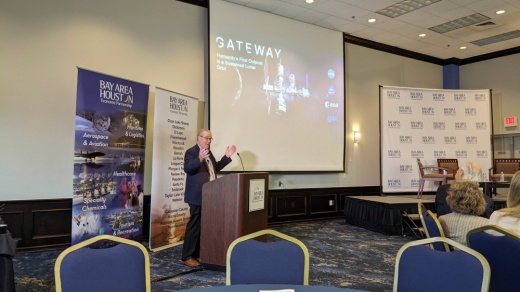NASA is preparing to return to the moon in a few months, and the Johnson Space Center will continue to rely on the Bay Area workforce to make that and future missions happen, NASA leaders said.
During a Bay Area Houston Economic Partnership meeting Nov. 3, three Johnson Space Center leaders spoke about Artemis, NASA’s spaceflight program that will return humans to the moon for the first time since 1972; Gateway, the small space station that will orbit the moon and allow astronauts to do research and move to and from the lunar surface; Orion, the new space vehicle that will take astronauts from Earth to Gateway and the moon; and the International Space Station.
“We are about to fly,” said Paul Marshall, Orion program manager for NASA, who noted Artemis I, a mission without a crew, is targeting a February launch date.
This mission will see Orion fly around the moon as a test of its capabilities before a crewed flight, Artemis II, in 2024, Marshall said.
Artemis I is set up and close to ready to launch in Florida. Rockets have been fueled and prepared for ignition; Orion is stacked on top; and crews are in the final weeks of testing and preparation, Marshall said.
“It’s an incredible sight,” he said.
Additionally, suppliers and manufacturers around the globe are preparing for the Artemis II, III and IV missions, which will each launch about a year apart, Marshall said.
“Just as we’re poised right now for our first flight, we’re well into production of the vehicles,” he said.
The Orion program supports a large industry in the state’s economy. Today, the program has over 4,000 civil servants and subcontractors. In Texas, there were 81 suppliers, 44 of which are from the Greater Houston area; 1,200 jobs, and $300 million spent, mostly in the Houston area, due to the Orion program, all in fiscal year 2021 alone, Marshall said.
Meanwhile, NASA is shooting for a November 2024 launch for Gateway. Like the ISS but smaller, Gateway will orbit the moon and allow astronauts to live and work and travel to and from the lunar surface, Gateway program manager Dan Hartman said.
Gateway will have a 15-year life and allow astronauts to live on board for 30 to 60 days. Astronauts will be able to go to the moon for six to seven days and return to Gateway to continue research before returning to Earth, Hartman said.
When astronauts go to the lunar surface, they will take high-definition video in 4K resolution, giving the public a more accurate glimpse of the moon than the grainy videos they are used to, Hartman said.
Like the ISS, international partners in Europe, Japan, Canada and beyond are working with NASA on creating different modules and hardware for Gateway.
The Gateway program is small with about 30 members so far, Hartman said.
“When you talk about building a space station around the moon, you can attract a tremendous amount of talent. We try to bring in the best of the best,” he said. “It’s amazing what you can do with a tight-knit group that’s really, really talented.”
Still, the program results in several jobs and dollars spent in the Bay Area. The spending for Gateway contractors located in the Bay Area to date is about $172.8 million, which is over 17% of Gateway funding to date, Hartman said. About 950 civil servants and contractors support the program.
Despite NASA turning its attention to the moon, the agency is not done with the ISS. On Nov. 2, the ISS celebrated 21 years of continuous human presence.
The ISS is cleared to orbit the Earth through 2024, though there is little doubt it will be operating through 2030, ISS program manager Joel Mantalbano said.
“We want to go to at least 2030,” he said.
The ISS has had recent mishaps, including two—one over the summer and one in October—inadvertent firings of a Russian module’s thrusters that briefly tiled the ISS out of position in orbit. Additionally, there is a small air leak in one of the modules crews have yet to find and patch, resulting in the ISS losing about a pound of air a day, Mantalbano said.
These are not safety concerns, and Mantalbano said he is confident the leak will be found and patched.
The ISS enables commercial transportation with private companies. For instance, SpaceX is now delivering cargo and crews to the ISS, and Boeing will conduct crew missions to the station as well. Sierra Nevada in 2022 is slated to deliver cargo to the ISS, Mantalbano said.
The fiscal year 2022 budget for the Johnson Space Center is $2.3 billion. About 2,500 contractors and 835 civil servants work to support the ISS, and extending its life means extending workforce contracts in the Bay Area, Mantalbano said.





